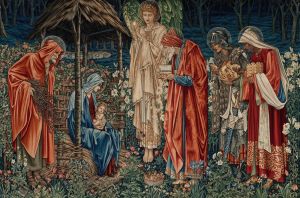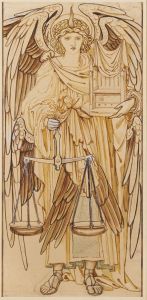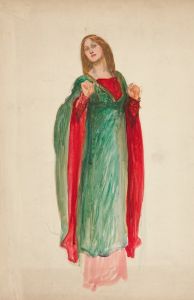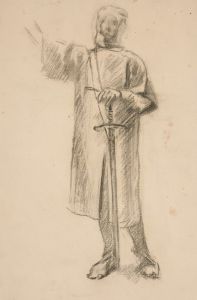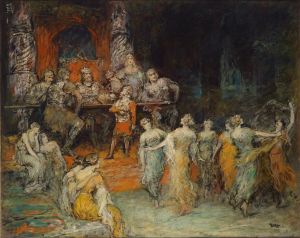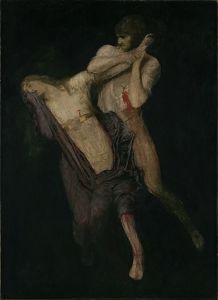
Astolf Riding Away with the Head of Orill
A hand-painted replica of Arnold Böcklin’s masterpiece Astolf Riding Away with the Head of Orill, meticulously crafted by professional artists to capture the true essence of the original. Each piece is created with museum-quality canvas and rare mineral pigments, carefully painted by experienced artists with delicate brushstrokes and rich, layered colors to perfectly recreate the texture of the original artwork. Unlike machine-printed reproductions, this hand-painted version brings the painting to life, infused with the artist’s emotions and skill in every stroke. Whether for personal collection or home decoration, it instantly elevates the artistic atmosphere of any space.
Arnold Böcklin's painting "Astolf Riding Away with the Head of Orill" is a notable work by the Swiss symbolist artist, created in 1888. Böcklin, renowned for his imaginative and often fantastical compositions, drew inspiration from mythology, literature, and his own vivid imagination. This particular painting is based on a tale from Ludovico Ariosto's epic poem "Orlando Furioso," which was first published in the early 16th century.
"Orlando Furioso" is a chivalric romance that weaves together various stories of knights, magic, and adventure. One of the episodes in the poem involves the character Astolfo, a knight and one of Charlemagne's paladins. In the narrative, Astolfo embarks on a series of adventures, one of which involves the sorcerer Orillo, who possesses the magical ability to reattach his severed head. Astolfo, in his quest, manages to overcome Orillo by taking his head and preventing it from reattaching, thus defeating the sorcerer.
Böcklin's painting captures the dramatic moment of Astolfo's triumph. The artwork is characterized by Böcklin's distinctive style, which often includes a dreamlike atmosphere and a meticulous attention to detail. In "Astolf Riding Away with the Head of Orill," Böcklin employs a rich color palette and dynamic composition to convey the intensity and motion of the scene. Astolfo is depicted on horseback, holding the severed head of Orillo, with the landscape around him suggesting a sense of movement and urgency.
The painting reflects Böcklin's fascination with themes of heroism, mythology, and the supernatural. His work often blurs the line between reality and fantasy, inviting viewers to explore the deeper meanings and emotions embedded within the imagery. Böcklin's ability to evoke a sense of mystery and wonder is evident in this painting, as he brings to life a legendary tale through his unique artistic vision.
Arnold Böcklin was a significant figure in the Symbolist movement, which emerged in the late 19th century as a reaction against the realism and naturalism that dominated the art world at the time. Symbolist artists sought to express the intangible and the mystical, often drawing on literature, mythology, and dreams as sources of inspiration. Böcklin's work, including "Astolf Riding Away with the Head of Orill," exemplifies these characteristics, as it delves into the realms of myth and imagination.
Throughout his career, Böcklin's paintings were celebrated for their technical skill and imaginative content. His work had a profound influence on later artists, particularly those associated with the Surrealist movement, who admired his ability to create fantastical worlds that challenged conventional perceptions of reality.
"Astolf Riding Away with the Head of Orill" remains an important example of Böcklin's contribution to Symbolism and his enduring legacy in the art world. The painting is a testament to his skill in storytelling through visual art, capturing the essence of a legendary narrative while inviting viewers to engage with the mystical and the unknown.





